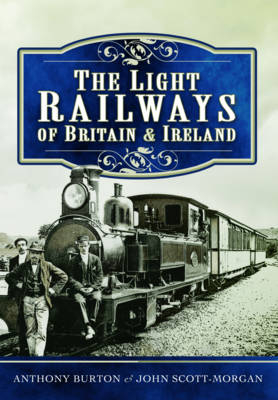
Light Railways of Britain and Ireland
Seiten
2015
Pen & Sword Books Ltd (Verlag)
978-1-4738-2706-6 (ISBN)
Pen & Sword Books Ltd (Verlag)
978-1-4738-2706-6 (ISBN)
- Keine Verlagsinformationen verfügbar
- Artikel merken
This book covers the story of Britain's last railway development, the Rural light railways constructed as a result of the 1896 act.
First published in 1985 by Moorland Press, The Light Railways of Britain & Ireland has remained unavailable for more than twenty-five years, until now. Re-released by Pen & Sword, this is a thorough and engaging book that covers, in depth, the fascinating story of Britain's last railway development, the Rural light railways, constructed as a result of the Light Railways Act 1896. Rigorously detailed, it charts the overall history of the last great railway boom in Britain - the light railway boom - from 1896, to the beginning of the Great War in 1914. During this period a large number of narrow and standard gauge lines were constructed in both Britain and Ireland, in order to serve and open up areas in both countries that, at the time, lacked adequate transport links. This book tells the story of how these lines were constructed and why, in most cases, they eventually failed, due to post-First World War road competition. Authored by two highly acclaimed writers of transport history, this is a true testament to, and a timely reminder of, Britain's last railway development.
First published in 1985 by Moorland Press, The Light Railways of Britain & Ireland has remained unavailable for more than twenty-five years, until now. Re-released by Pen & Sword, this is a thorough and engaging book that covers, in depth, the fascinating story of Britain's last railway development, the Rural light railways, constructed as a result of the Light Railways Act 1896. Rigorously detailed, it charts the overall history of the last great railway boom in Britain - the light railway boom - from 1896, to the beginning of the Great War in 1914. During this period a large number of narrow and standard gauge lines were constructed in both Britain and Ireland, in order to serve and open up areas in both countries that, at the time, lacked adequate transport links. This book tells the story of how these lines were constructed and why, in most cases, they eventually failed, due to post-First World War road competition. Authored by two highly acclaimed writers of transport history, this is a true testament to, and a timely reminder of, Britain's last railway development.
Anthony Burton is an author and broadcaster, who has written many reputable books on history, industrial history and transport history. He was born in 1934 and now lives in Stroud, Gloucestershire, with his wife. John Scott-Morgan is an author of thirty-two books on railway history and a leading writer on light railway subjects. He was the founder of the British Overseas Railways Historical Trust, an educational trust dedicated to preserving archives connected with Britain's contribution to world railway development. Born in London in 1954, John now lives in Woking, Surrey.
| Zusatzinfo | 200 B & W illustrations, including photos and memorabilia |
|---|---|
| Verlagsort | Barnsley |
| Sprache | englisch |
| Maße | 210 x 297 mm |
| Themenwelt | Natur / Technik ► Fahrzeuge / Flugzeuge / Schiffe ► Schienenfahrzeuge |
| ISBN-10 | 1-4738-2706-X / 147382706X |
| ISBN-13 | 978-1-4738-2706-6 / 9781473827066 |
| Zustand | Neuware |
| Informationen gemäß Produktsicherheitsverordnung (GPSR) | |
| Haben Sie eine Frage zum Produkt? |
Mehr entdecken
aus dem Bereich
aus dem Bereich
Das Beste aus Stadt und Land.
Buch | Softcover (2024)
VUD Medien (Verlag)
12,00 €
Buch | Softcover (2024)
hidden europe publications (Verlag)
26,15 €
die visuelle Chronik der Schienenfahrzeuge
Buch | Hardcover (2024)
DK Verlag Dorling Kindersley
34,95 €


